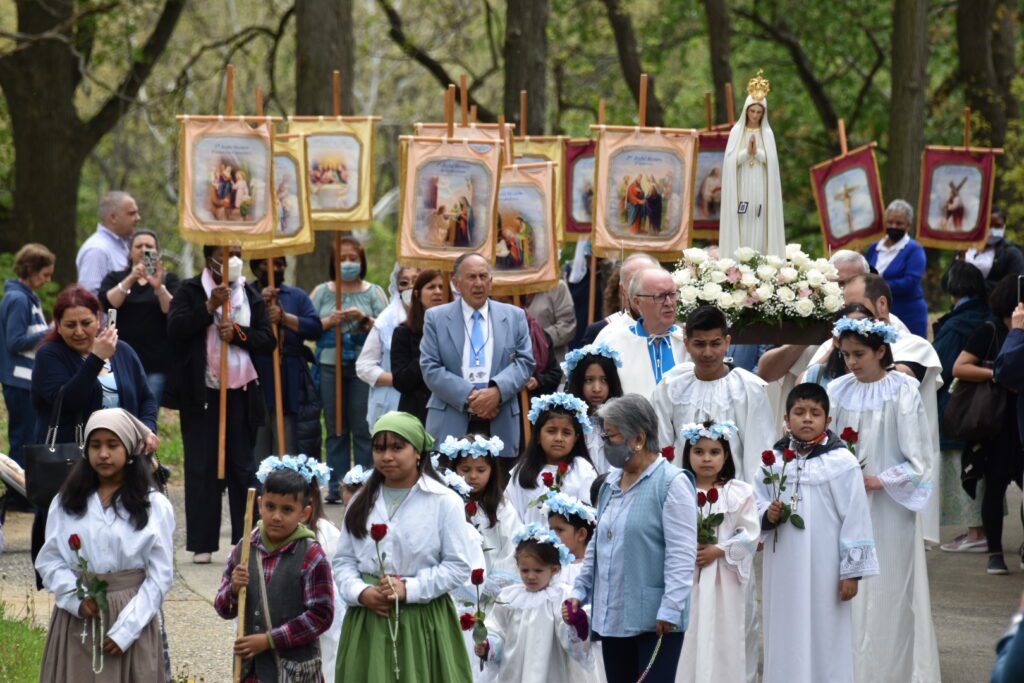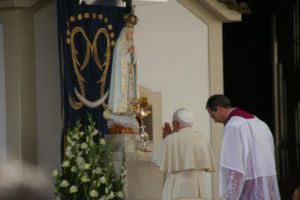by Barb Ernster –

In support of the U.S. Catholic Bishops’ National Eucharistic Revival (NER), the World Apostolate of Fatima is asking parishes in every diocese to host a Fatima Night Vigil of Reparation to renew the Church and help return Catholics, practicing and non-practicing, to belief in the real presence of Jesus in the Eucharist.
As we begin to roll out this initiative, we are praying that many parishes will respond and hold at least one night vigil of reparation in 2023, for the success of the National Eucharistic Revival.
FATIMA NIGHT VIGILS
The traditional Fatima all-night vigils sprang from the thousands of pilgrims who would come, many on foot, to the Cova da Iria at Fatima, to spend the whole night in prayer in anticipation of the 13-day celebrations. Eventually, the clergy in charge of the growing crowds and shrine began to expose the Blessed Sacrament throughout the night.
In his book Night of Love, our co-founder John Haffert reports: “They had no place to sleep except in or about the Cova da Iria, before attending Mass the following morning. On behalf of these thousands of pilgrims spending the night in the great natural amphitheater of Fatima, prayers and exhortations before our Eucharistic Lord sounded from the loudspeakers until Communion was distributed in the early morning hours to the tens of thousands of joyfully tired pilgrims … It seemed that Our Lady, who had appealed for reparation was literally drawing people to Our Lord in the Blessed Sacrament for a night of sacrifice and prayer.”
In 1960, an “official” recognition of the importance of the vigil came from His Holiness St. John XXIII. The pope had called Fatima the “hope of the world.” He met with the Bishop of Fatima, who subsequently wrote to all the other bishops of the world to announce a special all-night vigil of reparation at Fatima on October 13, 1960, suggesting that the bishops do something similar in their own dioceses. More than 300 bishops agreed. After the vigil, St. John XXIII sent a cable to the Bishop of Fatima expressing gratitude and a special blessing on all who participated in this vigil. It is believed that John XXIII also spent that entire night before the Blessed Sacrament in union with the pilgrims at Fatima and elsewhere in the world.
Within our apostolate, the all-night vigils of reparation to the Sacred Heart and Immaculate Heart began to take place on the evening of First Fridays to the morning of First Saturdays. The first one was held in New York City at St. John the Baptist Church near Penn Station in 1969. These all-night vigils spread to many cities and dioceses, promoted by the apostolate divisions.


However, as perpetual adoration chapels began to spring up in many dioceses, and with the shortage of priests, many of whom were serving several parishes, the Fatima all-night vigils began to decline.
But the times seem to be calling for renewed emphasis on heroic sacrifice and reparation. Most people are dealing with family members, children, grandchildren and friends who do not believe Jesus is present in the Eucharist or who have fallen away completely from the Catholic faith.
“ARE YOU WILLING TO OFFER YOURSELVES…”
Mary asked the three shepherd children in the very first apparition on May 13, “Are you willing to offer yourselves to God…as an act of reparation for the sins by which He is offended…?”
The word reparation means “to restore,” “to rebuild” or “to renew.” We cannot restore the Christian civilization, rebuild our Church and families and renew belief in the Holy Eucharist without reparation.
At the very beginning of Fatima, in 1916, the Angel of Peace made it very clear to the three children that God commands us to adore the Holy Trinity and make reparation to the Body, Blood, Soul and Divinity of Jesus Christ, present in all the tabernacles of the world. He demonstrated that they bow down before the Eucharist and said in a very serious tone: “REPAIR THEIR CRIMES” and “CONSOLE YOUR GOD!”


He taught them a prayer of reparation for the “offenses, sacrilege and indifference” toward the Body and Blood of Jesus in the Eucharist. These sins have grown exponentially through the decades and are even tolerated today by leaders of the Church and Catholics who serve God with their lips but not their hearts.
The Fatima message ends with the Holy Trinity and a stark image of the precious Body and Blood of Jesus crucified, during the vision given to Sister Lucia in 1929. Here the Blood of Jesus is falling from the wounds of Jesus on the cross to the host and chalice beneath his right arm. Our Lady stands at the cross, pointing to her Immaculate Heart, pierced by a crown of thorns. The words “Grace and Mercy” flow like water from beneath the left arm of Christ.


GOD WANTS TO POUR DOWN GRACE AND MERCY ON THOSE WHO HAVE WALKED AWAY FROM HIM—THE UNBELIEVERS, THE LUKEWARM, THE INDIFFERENT. WE CAN HELP BRING IT ABOUT BY OUR PERSONAL SACRIFICE AND REPARATION, IN COMMUNION WITH OTHERS IN THE FAITH.
WILL YOU HELP US?
We need your help in bringing this to parish priests. We are asking them to do one all-night vigil of reparation before our Eucharistic Lord, whether it be on a First Friday/First Saturday evening, or on the night before a 13th day of Fatima, or any other evening that works for them. The point is to make this sacrifice for those who do not believe, do not adore, do not hope and do not love God.
The Blue Army was described by Mr. Haffert as “a response to the Message of Fatima, an army on its knees with hearts open to the Heart of Mary.” The World Apostolate of Fatima is calling that army to its knees once again.
LEARN MORE
For more information on the program, materials and resources, contact Barb Ernster, [email protected].


This article was originally published in the Fall 2022 issue of Soul Magazine. Barb Ernster is the Communications Manager/Editor for the World Apostolate of Fatima, USA.











